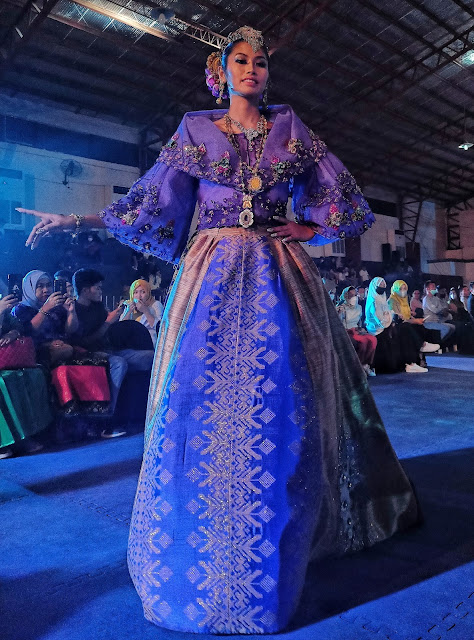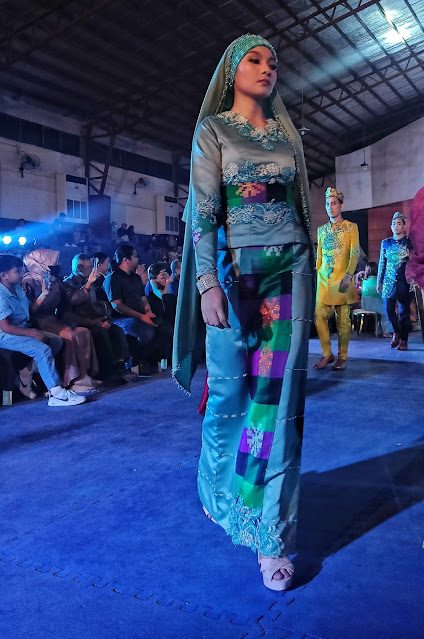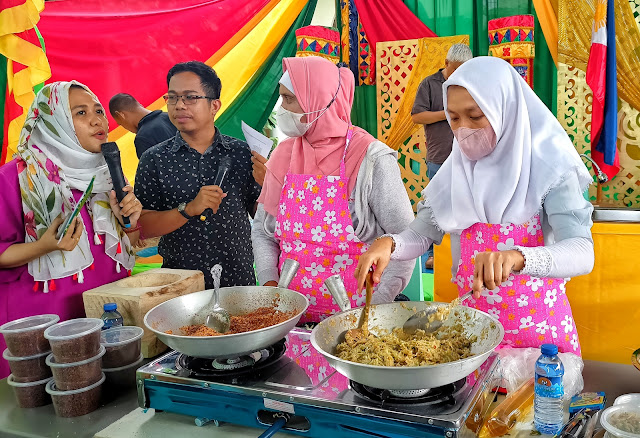Every year, Cotabato City honors the life of the man credited with bringing Islam to Mindanao with a week-long festival. Shariff Kabunsuan, to whom the celebration is named after, was an Arab-Malay from Johore, Malaysia who led an expedition to the islands of Lanao and Maguindanao in the early 16th century to preach Islam.
 |
| A fluvial parade of Guinakit boats was held as the finale of the festival |
This writer had heard of the Shariff Kabunsuan Festival from other travel writers but had little prior understanding of it. Being given the opportunity to cover it allowed me to learn more about the numerous inspirations that go into its celebration. With the Bangsamoro region's history at the forefront of the festivities, the week-long time I spent covering the festival provided me with an in-depth study of the cultural diversity and fascinating traditions of the people of Bangsamoro.
In keeping with the festival's theme of "One Heritage, One Culture, Endless Possibilities," which honors the Bangsamoro homeland and its people for their shared history, vibrant but different cultures, skillful handicraft, distinctive traditions, and stunning scenery, here are a series of events that made this year’s Shariff Kabunsuan Festival a giant success.
Kuyog street dancing competition
The opening salvo of the 2022 Shariff Kabunsuan Festival was a medley of roars, energetic choreography, and thunderous drumming rhythms, as competing groups from North Cotabato, Lanao del Sur, Maguindanao del Norte, and Sultan Kudarat paraded in brightly colored costumes and extravagant headdresses.
 |
| Contingents in colorful costume all provided entertaining performances |
The brilliant exhibition of dancing and drumming energy kept the crowds that flocked to Cotabato State University's Grand Stand wildly entertained.
 |
| All smiles are the winning group from North Cotabato |
As each section of the audience roared in support of their favorites, the performers from Tulunan, North Cotabato emerged as the undisputed winners of the day. They won the first prize of 300,000 pesos, with the contingent from Isulan, Sultan Kudarat taking home the second-place windfall of 200,000 pesos and Sultan Kudarat, Maguindanao rounding out the top three with a 100,000-peso bounty. Consolation cash prizes were also given to the other three non-winning groups.
 |
| The field of Cotabato State University was transformed into a theatrical stage |
A dramatization of Shariff Kabunsuan's arrival in Mindanao preceded the Kuyog competition. The performance also told the stories of two brothers, Mamalu and Tabunaway, who lived during the time when Islam was originally introduced to Mindanao. Tabunaway accepted to be converted to Islam, however Mamalu kept his ancestors' pagan views, resulting in Mindanao's diversity.
Inawl Fashion Show highlighting the beauty of the Inaul cloth
Cotabato State University's gymnasium was transformed into an oval catwalk where a slew of gorgeous models showcased the work of local designers who were inspired by the Inaul woven culture of Maguindanao.
 |
| The Inaul Cloth in a Filipiniana gown |
By merging the five main patterns of Inaul weaving—Sikukaruwang, Lombayan, Karanda, Biyaludan, and Sikuaundune with elaborate designs and a spectrum of vivid hues—the Inaul tradition of Maguindanao is given new life as the focal point of embellishment for formal gowns and outfits influenced by Moro traditional fashion.
 |
| One of the crowd's favorite Inaul-inspired dress |
For a cloth once only used as a malong, the journey of the Maguindanaoan Inaul reaches creative heights as it is now being transformed into stunning modern clothing while still retaining its century-old emblem of strength, kingship, dignity, and nobility.
 |
| Local designers sure did a wonderful job |
The audience's enthusiastic response at the Inawl Fashion Show demonstrates how the use of Inaul cloth in contemporary fashion is helping preserve an olden culture. With growing demand it encourages weavers to create continuously, thus breathing soul into the centuries-old art of Inaul weaving.
Bonus dose of history
Finding a small window from the many festivities, we explored the city for some dose of history. Our first destination is the Bangsamoro Museum.
 |
| the 21 burial jars on display |
Among the many fascinating displays inside the museum was a written timeline of the modern history of the Bangsamoro, but my personal favorites were the 21 limestone secondary burial jars unearthed on the Kulamana Plateau in South Cotabato and in Palimbang, Sultan Kudarat.
 |
| The Sinini. The chef used goat meat for this dish. |
Researchers from the University of San Carlos (USC) in Cebu first uncovered the jars in the early 1960s. Soon, experts from other countries joined in, and they continued to do so until the early 1970s, when Ferdinand Marcos ordered the bombing of the region following the declaration of Martial Law. Carbon dating puts these jars to around 2,000 - 2,500 years old.
 |
| The Daral is a famous Tausug delicacy that comes with sweetened coconut meat filling |
Because the body is typically left to decompose until it is stripped to the bones, the jars are referred to as secondary burial jars.
 |
| Cooks demonstrates some Bangsamoro dishes during the Culinary Showcase |
The older burial jars came in quadrilateral shapes with cylindrical lids. The bodies of the jars are decorated with different geometric designs, and the lids are adorned with depictions of human features that hint at the gender of the deceased. (often phallic in males and mammary in females).
Side-trip to the Grand Mosque
No visit to Cotabato City is complete without seeing the splendor of the Grand Mosque or the Sultan Haji Hassanal Bolkiah Mosque. Despite having seen it from every perspective conceivable during my prior visits to Cotabato, the feeling of spirituality it exudes and the gorgeous appearance it displays remain a source of fantastic wanderlust experience for me.
 |
| The view of the Grand Mosque nearing sunset |
This time, I saw it from the lens of my drone as it swivels in the air capturing the waters of Tamontaka River and the surrounding hilltops as well. Truly, every moment spent in the presence of the Grand Mosque is magical.
Bangsamoro culinary showcase
The festival's Culinary Showcase added depth to our gastronomic exploration. During the December 17 event, traditional Bangsamoro delicacies were demonstrated to us by local chefs and cooks. We were shown, from the gathering of ingredients to the final plating, the process of making several classic Moro main dishes and appetizers.
 |
| A feast of Bangsamoro dish served on dulang |
We dined on Sinini—a Kambing dish, Lininggil of Maguindanao, Tiyula Itum, a Tausug recipe, and the Maranao's Palapa sakurab and niyug, all of which were served to us on a dulang in a manner typical of a traditional pagana meal. After that, we dug into the appetizers and desserts, including Tapay (fermented rice), Bulibid, Daral and Kumukunsi.
Guinakit fluvial parade: a
fitting festival finale
Serving as the festival’s grand finale is the Guinakit Fluvial Parade which honors the arrival of Shariff Kabunsuan arrival on the banks of ‘Masla Pulangi’ (Rio Grande de Mindanao).
 |
| Colorful Guinakit boats |
From the Maguindanaoan word "Guinakit" ("convoy of boats"), it describes the Moro boats used by the royal family. Legend has it that Shariff Kabunsuan sailed in one much like it.
 |
| View from the air |
Made from wooden materials and elaborately adorned with flamboyant Muslim garb, almost a hundred Guinakit floated down the waters of Tamontaka river, bearing musicians playing traditional Moro musical instruments and actors portraying Shariff Muhammed Kabungsuwan and his entourage.
 |
| A closer look at one of the Guinakit boats |
Hundreds of onlookers lined the paved bay walk on the banks of Tamontaka River to witness the massive fleet sail through the calm waters on a myriad of formations.
 |
| The waters leading to Moro Gulf |
As the last boat arrived at the embankment marking the end of the fluvial parade, revelers reflected on the year's highly successful Shariff Kabunsuan celebration with smiles on their faces.
 |
| With fellow travel writers covering the 2022 Shariff Kabunsuan Festival |
More than 500 years since his arrival, Shariff Kabunsuan remains a vessel for the Bangsamoro to continue showcasing their rich history and colorful culture. Its only proper that we take notice and learn their fascinating stories.






















